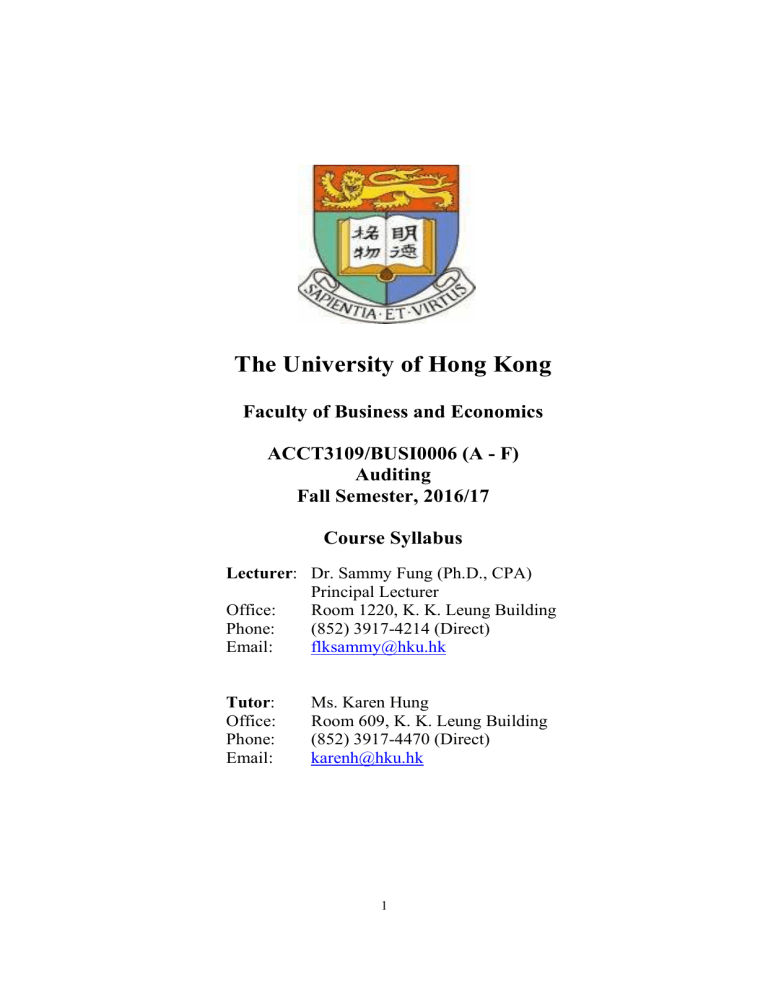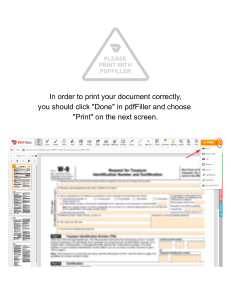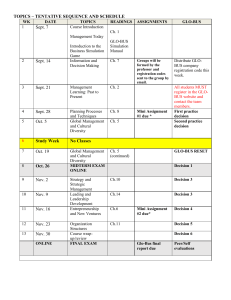
The University of Hong Kong Faculty of Business and Economics ACCT3109/BUSI0006 (A - F) Auditing Fall Semester, 2016/17 Course Syllabus Lecturer: Dr. Sammy Fung (Ph.D., CPA) Principal Lecturer Office: Room 1220, K. K. Leung Building Phone: (852) 3917-4214 (Direct) Email: flksammy@hku.hk Tutor: Office: Phone: Email: Ms. Karen Hung Room 609, K. K. Leung Building (852) 3917-4470 (Direct) karenh@hku.hk 1 COURSE DESCRIPTIONS This course examines the role of the external auditor on financial statement reporting and the needs for external auditing in the commercial sector. Assurance services other than auditing will also be discussed and examined. By the end of the course, students should be able to gather enough knowledge on the nature of the auditing profession to decide whether they wish to embark on a public accounting career. Textbooks reference: 1. Karla M. Johnstone, Audrey A. Gramling and Larry E. Rittenberg. 2016. Auditing: th A Risk-Based Approach to Conducting a Quality Audit, 10 Edition, South-Western Cengage Learning; 2. Code of Ethics for Professional Accountants (COE) issued by the Hong Kong Institute of Certified Public Accountants (HKICPA). Pre-requisite: BUSI0020 Intermediate Accounting II/ACCT3103 Intermediate Financial Accounting II COURSE OBJECTIVES 1. Provide students with basic concepts of auditing theory, concepts, methodology and practice; 2. Provide students with the capability to apply knowledge in gathering audit evidence and in evaluating the financial statement assertions; 3. Inculcate professional judgment in various auditing and ethical scenarios; 4. Develop students’ communication skills. INTENDED LEARNING OUTCOMES (ILOs) On completion of the course, students will be able to: ILO1. Describe and explain the financial statement auditing process; ILO2. Use relevant information for making decisions of client acceptance, risk assessment, as well as extent of audit work; ILO3. Apply Code of Ethics for Professional Accountants to resolve an ethical situation; ILO4. Demonstrate effective verbal and writing communication skills. ALIGNMENT OF PROGRAM AND COURSE ILOs Program ILOs 1. Acquisition and internalization of knowledge of accounting, business and economics 2. Application and integration of knowledge 3. Inculcating professionalism and leadership 4. Mastering communication skills 2 Course ILOs ILOs 1 & 2 ILOs 2, 3 & 4 ILOs 2 & 3 ILO 4 TEACHING AND LEARNING ACTIVITIES (TLAs) TLA1. Situation: Lectures and in-class exercises, discussions & quizzes • • • • Lectures: basic knowledge and concept of auditing is presented with PowerPoint slides. In-class exercises: basic concepts and techniques are illustrated using examples. Students work through in-class exercises along with the lecturer. These exercises help students follow the lectures closely and actively. In-class discussions: students are encouraged to raise questions, participate in discussions and share opinions with their peers. These discussions encourage students to think more for certain arguable topics. In-class quizzes: students are required to complete 2 in-class quizzes in the semester. These quizzes assist students to better understand the learning objectives of each topic and to ensure they have grasped the necessary concepts and theories of auditing. Major focus: ILOs 1, 2, 3 and 4. TLA2. Situation: Tutorials • • Weekly tutorial assignments: students are required to complete assigned homework before each tutorial session on an individual basis. In-class interactive activities: students are required to interact with the tutorial instructor, and participate in the in-class exercises and discussions actively. Major focus: ILOs 1, 2, 3 and 4. TLA3. Situation: Group presentations and outside-classroom activities • • Group presentations: students are expected to perform at least one group presentation in the semester. Each group should have 4 – 5 students. Students will complete an assigned cases analysis and deliver group presentation in the small group lecture. Once the topic is assigned, each group should work as a team and contribute jointly to discuss and analyze the topic, assign responsibility for the topic and present the topic and manage Q&A session in class. Outside-classroom activities: the lecturer will provide consultation to address students’ questions and doubts related to the course on appointment basis. Major focus: ILOs 2, 3 and 4. ESTIMATED STUDY LOAD Expected Contact hours Course Teaching and Learning Activities TLA1. Interactive lectures TLA2. Tutorials TLA3. Group presentation Self study Total 32 11 30 47 120 3 Study Load (%) 26.67% 9.17% 25.00% 39.16% 100.00% ASSESSMENT TASKS/ACTIVITIES (ATs) Assignments and tutorial in-class participation Group presentation In-class quizzes Mid-Term examination Final examination Total 10% 15% 10% 25% 40% 100% AT1. Assignments and tutorial in-class participation (10%) Students are expected to attend and participate actively in tutorials. Being absent from class will negatively affect students’ participation performance. Each student will be appraised by the tutor individually. Written assignments and exercises will be assigned for each topic to access the students’ ability to comprehend the concepts discussed during lectures. Students are also required to attempt selected assignments before commencement of the tutorials. Part of the coursework assessment will be allocated to individual performance in the class discussions of the homework assignments. Participation and assignments are evaluated per student by the tutorial instructor. The objective of the tutorials is to help students digest and apply the knowledge they have learned from the classes. Grading Criteria ILO ILO 1, 2, 3 and 4. A+ A A- B+ B B- C+ C C- D+ D Extremely well prepared for class discussion, active in sharing views and attended at least 90% of classes. Submitted all homework with 90% accuracy. Partially prepared for class discussion, quite active in sharing views and attended at least 80% of classes. Submitted at least 80% of homework with 80% accuracy. Not well prepared for class discussion, limited active in sharing views and attended at least 70% of classes. Submitted at least 70% of homework with 70% accuracy. Not well prepared for class discussion, no sharing of views and attended at least 60% of classes. Submitted at least 60% of homework with 60% accuracy. F Never prepared for class discussion and no sharing of views and experience and attend less than 60% of classes. Submitted less than 60% of homework with less than 60% accuracy. AT2. Group Presentation (15%) A number of formal group presentations will be scheduled throughout the semester. Each group should consist of THREE TO FOUR students. Each group of students is required to deliver a formal presentation of 25 to 30 minutes on the assigned case, plus Q&A session. Each group is required to submit the case report of FIVE pages after the presentation. The group presentation will be evaluated based on the following five criteria: 1) presentation style; 2) the use of presentation/ visual aids; 3) the contents and organizations; 4) the extent of research and 5) the quality of interaction at the Q&A sessions. A feedback meeting with the lecturer will be scheduled in the subsequent class following each presentation. 4 Grading Criteria ILO ILOs 2, 3 and 4. A+ A A- B+ B B- C+ C C- D+ D Very Good to excellent ratings on some or all five criteria. Good to very good ratings on some or all five criteria. Fair to good ratings on some or all five criteria. Fair ratings on all five criteria. F Fail to prepare and present the case. AT3. In-class Quizzes (10%) Two closed book quizzes consist of multiple-choices questions will be offered to gauge students’ understanding of the auditing principles on a continuous basis and to test students’ problem solving skills. Grading Criteria ILO ILOs 1, 2 and 3. A+ A A- B+ B B- C+ C C- D+ D Scored correctly on more than 90% of the multiple choice questions. Scored correctly on less than 90% of the multiple choice questions. Scored correctly on less than 80% of the multiple choice questions. Scored correctly on less than 70% of the multiple choice questions. F Scored correctly on less than 60% of the multiple choice questions. AT4. Mid-Term Examination (25%) A closed book mid-term examination schedule on Nov 4, 2016 Friday evening will be used to gauge students’ understanding of the auditing principles on a continuous basis and to test students’ problem solving skills. Grading Criteria ILO ILOs 1, 2 and 3. A+ A A- B+ B B- C+ C C- D+ D Provided accurate solutions to all problems, gave detailed and insightful responses to essay questions and scored correctly on more than 90% of the multiple choice questions. Provided accurate solutions to some problems, gave detailed responses to some essay questions and scored correctly on less than 90% of the multiple choice questions. Provided accurate solutions to a few problems, gave limited responses to some essay questions and scored correctly on less than 80% of the multiple choice questions. Provided inaccurate solutions to a few problems, gave unclear responses to most essay questions and scored correctly on less than 70% of the multiple choice questions. 5 F Skipped some problems or provided inaccurate solutions to most problems, gave poor responses to most essay questions and scored correctly on less than 60% of the multiple choice questions. AT5. Final Exam (40%) The final examination will be held in the normal exam period. It is a closed book, comprehensive and covers all the chapters on the course syllabus. With the exception of extremely special cases, NO MAKEUP exam will be allowed if students fail to seek ADVANCE permission from the instructor. The objective of the final exam is to further enhance students’ understanding of the course and their application of judgmental skills on various auditing issues. Grading Criteria ILO ILOs 1, 2, 3 and 4. A+ A A- B+ B B- C+ C C- D+ D Provided accurate solutions to all problems, gave detailed and insightful responses to essay questions and scored correctly on more than 90% of the multiple choice questions. Provided accurate solutions to some problems, gave detailed responses to some essay questions and scored correctly on less than 90% of the multiple choice questions. Provided accurate solutions to a few problems, gave limited responses to some essay questions and scored correctly on less than 80% of the multiple choice questions. Provided inaccurate solutions to a few problems, gave unclear responses to most essay questions and scored correctly on less than 70% of the multiple choice questions. F Skipped some problems or provide inaccurate solutions to most problems, gave poor responses to most essay questions and scored correctly on less than 60% of the multiple choice questions. ACADEMIC CONDUCT Plagiarism and copying of copyright materials are serious offences and may lead to disciplinary actions. Students should read the chapters on “Plagiarism” and “Copyright” in the Undergraduate/Postgraduate Handbook for details. Students are strongly advised to read the booklet entitled “What is Plagiarism” which was distributed to them upon their admission into the University, a copy of which can be found at www.hku.hk/plagiarism. A booklet entitled “Plagiarism and How to Avoid it” is also available from the Main Library. Students are required to attend all the lectures and tutorials on time. In case they cannot attend, they should inform the instructor beforehand. 6 SCHEDULE OF LECTURES MAIN LECTURES Date (Tue) Topic SUB-LECTURES Date (Wed &Thur) Case Analysis & Presentation Chapter Sept 6 Auditing: Integral to the Economy Sept 7, 8 Warm-up; briefing of group Ch. 1 presentation; group formation Sept 13 The Risk of Fraud and Mechanisms to Address Fraud: Regulation, Corporate Governance, and Audit Quality Sept 14, - Introduction of the Code of 15 Ethics for Professional Accountants - A sample practice ethics question in HKICPA QP exam Ch. 2 Sept 20 Internal Control over Financial Reporting: Management’s Responsibilities and Importance to the External Auditors Sept 21, Case 1 – PCAOB 22 (Textbook: P1-61) Ch. 3 Sept 27 Professional Auditing Standards and the Audit Opinion Formulation Process Sept 28, Case 2 –Koss Corporation 29 (Textbook: P2-51) Ch. 5 Oct 4 A Framework for Audit Evidence (Quiz 1 on Oct 4, 2016) Oct 5, 6 Case 3 – Chesapeake Petroleum and Supply, Inc. (Textbook: P3-79) Ch. 6 Oct 11 Planning the Audit: Identifying and Responding to the Risks of Material Misstatement Oct 12, 13 Case 4 – General Motors (Textbook: P5-92) Ch. 7 Reading Week – October 17 – 21, 2016 (week 8) Oct 25 Auditing the Revenue & Payment Cycle Oct 26, 27 Ch. 9, 11 Case 5 – Longtop Financial Technologies Ltd and Deloitte Touche Tohmatsu CPA Ltd (Textbook: P6-70) Mid-Term Examination – Nov 4, 2016 (Friday) Time: 7pm to 9pm Venue: KK201, KK202, LE2 Coverage: 1 to 3, 5, 6 & Code of Ethics Nov 1 Substantive Testing – Accounts Receivable, Cash, Marketable Securities Nov 2, 3 Case 6 – Lincoln Federal Savings and Loan (Textbook: P7-59) 7 Ch. 9, 10 MAIN LECTURES Date (Tue) Topic SUB-LECTURES Date (Wed &Thur) Case Analysis & Presentation Case 7 – UTStarcom, Inc. (Textbook: P9-77) Chapter Nov 8 Substantive Testing –Inventory, PPE and Intangible Assets (Quiz 2 on Nov 8, 2016) Nov 9, 10 Nov 15 Activities Required in Completing a Quality Audit Nov 16, Case 8 – Parmalat 17 (Textbook: P10-72 & P10-75) Ch. 14 Nov 22 Audit Reports on Financial Statements Nov 23, 24 Ch. 15 Nov 29 Guest lecture and final wrap up No class No class 8 Ch. 11, 12 SCHEDULE OF TUTORIALS Discussion Topic Questions Period Sept 1 – Sept 9 (week 1, 2) No class -Sept 12 – Sept 16 (week 3) Ch. 1 P1-50 Sept 19 – Sept 23 (week 4) Ch. 2 P2-35 (i, j, k) Sept 26 – Sept 30 (week 5) Ch. 3 P3-46 Oct 3 – Oct 7 (week 6) Ch. 5 P5-84 Oct 10 – Oct 14 (week 7) Ch. 6 P6-48 (a to e) Reading week Oct 17 – Oct 21, 2016 (week 8) Oct 24 – Oct 28 (week 9) Ch. 7 P7-38 Oct 31 – Nov 4 (week 10) Ch. 9, 11 P9-50 Nov 7 – Nov 11 (week 11) Ch. 9, 10 P10-64 Nov 14 – Nov 18 (week 12) Ch.11, 12 P11-49 Nov 21 – Nov 25 (week 13) Ch.14 P14-72 Nov 28 – Nov 30 (week 13) Ch.15 P15-59 Hand-written Assignments To submit during tutorial <Note a> -- P1-29, P1-49 P2-32, P2-34 P3-44, P3-78 P5-54, P5-57 P6-41, P6-56 P7-50(a) P9-52, P9-57 P9-64, P10-52 P12-53, P12-57 P14-79, P14-87 P14-87 P15-61 Notes: (a) Each student must submit his/her HAND-WRITTEN assignment answers in A4 papers to submit during tutorial. Late submission is NOT allowed. (b) Students failing to submit assignments on time must seek approval from tutor with medical certificate within 24 hours from the due date and time. 9


